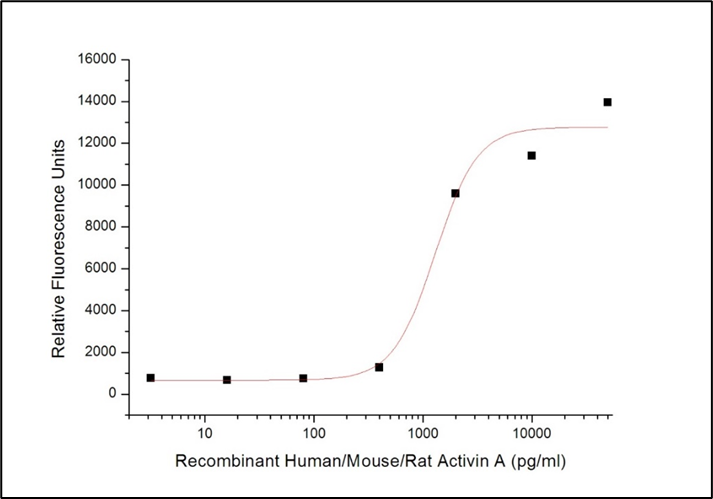#C687, Recombinant Human/Mouse/Rat Activin A
Recombinant Human Activin A is produced by our Mammalian expression system and the target gene encoding Gly311-Ser426 is expressed.
- Accession: P08476
- Known As: Inhibin beta A chain; INHBA; Activin A
- Mol Mass: 13 KDa
- APMol Mass: 15 KDa, reducing conditions
- Formulation Description: Lyophilized from a 0.2 μm filtered solution of 4mM HCl.
- Endotoxin: Less than 0.001 ng/µg (0.01 EU/µg) as determined by LAL test.
- Bioactivity

Measured by its ability to induce SMAD signaling in 293-Activin A Res cells(Cat#XCC11). The ED50 for this effect is 1.3 ng/ml.
- Reconstitution
Always centrifuge tubes before opening. Do not mix by vortex or pipetting.
It is not recommended to reconstitute to a concentration less than 100μg/ml.
Dissolve the lyophilized protein in distilled water.
Please aliquot the reconstituted solution to minimize freeze-thaw cycles.
- Storage
Lyophilized protein should be stored at < -20°C, though stable at room temperature for 3 weeks.
Reconstituted protein solution can be stored at 4-7°C for 2-7 days.
Aliquots of reconstituted samples are stable at < -20°C for 3 months.
- Shipping
Upon receipt, store it immediately at the temperature listed below.
- Background
Activin and inhibin are two closely related protein complexes that have almost directly opposite biological effects. Activins, members of the TGF-beta superfamily, are disulfide-linked dimeric proteins originally purified from gonadal fluids as proteins that stimulated pituitary follicle stimulating hormone (FSH) release. Inhibin’s/activins are involved in regulating a number of diverse functions such as hypothalamic and pituitary hormone secretion, gonadal hormone secretion, germ cell development and maturation, erythroid differentiation, insulin secretion, nerve cell survival, embryonic axial development or bone growth, depending on their subunit composition. Activins are homodimers or heterodimers of the various beta subunit isoforms, while inhibins are heterodimers of a unique alpha subunit and one of the various beta subunits.

